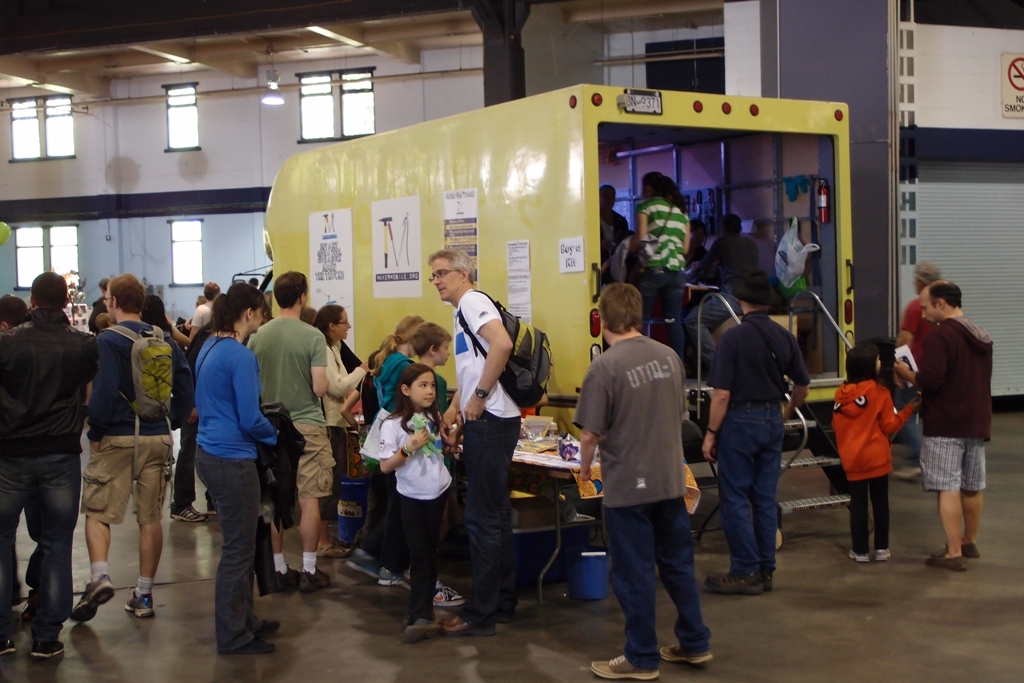Your kit contains the following parts:
- 2 resistors (coloured bands)
- 1 IC socket for the microcontroller
- 1 ceramic capacitor
- 1 polarized capacitor
- 1 pushbutton switch
- 1 coloured LED
- 1 PNP transistor (type 2N2907 or BC327 or 2N3906)
- 4 Infrared LEDs
- 4 NPN transistors (type 2N2222 or BC337)
- 1 ceramic resonator
- 1 Microcontroller (8-legged black device). Keep this planted in the special antistatic foam until you are ready to insert it into the finished circuit. If you live in an area with low humidity, or if you are noticing static when you touch door handles, it is advisable to ground yourself when handling static-sensitive devices. You can do this by touching exposed metal of a radiator, plumbing pipe etc, or the bare metal back panel of a (plugged-in) computer after you sit down at your workstation. Static charge which can build up by walking across a carpet or taking off a sweater is quite sufficient to totally destroy such devices. However, once installed in a circuit they are much less prone to damage.
- 1 battery holder for 2 AA alkaline batteries. You could also use three AAs as a power source (or two or three AAAs). A single lithium cell works really well, too, if you have a proper (safe) charger for it. The microcontroller, which is the brains of this operation, can only tolerate a maximum of 5.5 volts, so 3 alkalines or 1 lithium is as much as you can give it.
- 1 Printed Circuit Board (PCB). The components will all be placed on the side that has the printed text, while your solder joints will all be made on the other side. Notice how the outline of each component is shown on the top of the board.
- Self-adhesive pads to attach the battery holder to the PCB. These may be pre-installed on the battery holder.
Please read this section before starting to solder anything
If you have not done any electronic soldering before, or if it’s been a while, you should warm up and hone your skills on some scrap components and boards before proceeding.
When you go to solder a component:
- Touch the flux pen to the PCB holes on the back of the board. We don’t need much flux; if you can see it, you’ve got enough. The idea is to wet the metal where we want the solder to flow and form a joint. The flux cleans the surface and helps the molten solder stick to it. It’s magic. I can’t believe how many years it took me to see the light!
- Bend the component leads to the correct spacing, if necessary, THEN insert the component into its holes. Don’t assume the component will be able to form its own leads if pushed hard enough. It’s quite likely they will just break.
- Hold the component in place for soldering. If its leads are long and bendy, you can bend them outwards. If they are short and/or seem delicate, the method I like is to use a blob of Blu-Tack (poster putty) on the component side to hold the part in place. The heat can make the stuff get a bit gooey but it mops up easily enough with the main blob.
- Try to keep the soldering time to about 5 seconds or less per joint, and let each component cool down for 20 or 30 seconds before soldering another of its legs. This is particularly important for the transistors (it’s better for them if you leave about 3mm or 1/8 inch of lead between the transistor and the board as it helps dissipate some of the heat you are applying). If necessary, practice your soldering on some junk components before starting work on this kit. We can’t replace kits that were damaged during assembly.
Here’s what we are aiming for:
OK. Now let’s solder the components to the board in the following order. Read the notes for each part before you solder it.
Resistors (coloured bands). A resistor can be connected either way around. There are places for 4 resistors on the PCB but we only use two of them. It’s not because we are cheap - they are not actually required in this version of the TV-b-Gone. The positions in use are indicated on the board with check marks.
IC socket for the microcontroller. When soldering this, match the notch on one end with the white outline on the PCB.
Ceramic capacitor C1. This one doesn’t care which way around you connect it, provided you put it in the right place.Polarized capacitor C2 (small black cylinder). It matters which way around you connect this. The contrasting white stripe identifies the negative side; the other side is positive. Look for C2 on the PCB and you will see a + sign beside one of the holes. Enough said.
Pushbutton switch S1. Please note that in TV-b-Gone version 2 kits there is a small wire on the back of the PCB which must get soldered to one of the switch legs. Please ensure that you include this wire link in your soldering!
Coloured LED D5. This one is also a polarized component and the longer wire indicates its positive side. If both wires are the same length, look for a flat on the base of the plastic bulb - this indicates the negative lead.
PNP transistor (Looks similar but is different from the other four transistors). On the PCB this is just labelled PNP. Look carefully and you’ll see the outline in white of the curved and flat sides of this transistor. We must install it the correct way around. If necessary, carefully form the legs to the correct spacing: use needle-nose pliers to hold each lead close to the transistor body while you bend the lead with your fingers or another pair of pliers. MAKE SURE YOU DON’T PUT THIS PART IN THE SPOT MARKED X1 WHICH IS WHERE THE RESONATOR GOES!
4 Infrared LEDs LED1 through LED4. The grey ones produce a narrow beam while the clear ones produce a wider beam. It doesn’t matter which ones go in which of the spots 1 through 4. It is recommended to bend the leads at a sharp 90 degree angle as close to the LED body as possible while still allowing the LED to overhang the edge of the board. Otherwise you will find that the LEDs move around and point in different directions when bumped.
4 NPN transistors. Labelled Q1 though Q4 on the PCB. These are not the same as the other transistor! If the leads are not already pre-bent, carefully bend out the centre lead towards the curved side of the body and then back down parallel to the other two. Make sure they slide into their places without too much trouble before soldering them.
Ceramic resonator X1 (blue or yellow 3-legged device). Solder either way around. I like to put the text facing out so I know what it is. Note: When soldering the resonator, apply flux to both sides of the board and the legs of the component. The legs are quite weak and it helps to get solder flowing through the hole and up the leg a ways.
If you are in a class or someone is helping you, have them check your work at this point.
Now you just need to shorten the wires from the battery holder and solder them to the power terminals. These are at the switch end of the board either side of the coloured LED. The red positive wire goes to the hole that is marked “3-5V“. The unmarked hole is for the black wire. Now make sure that all leads on the back of the board are clipped very close to the board and attach the PCB to the battery holder using the self-adhesive pads. Finally, carefully slide the IC into its socket, putting the end with the dot close to the notch on the socket, and gently squeeze it fully into place.
Insert two fresh batteries and the LED should flash quickly for two seconds (this only happens when you change batteries or deliberately reset the device). Hold the button down and the coloured LED should come on. Check that the infrared LEDs are all connected and working by looking at them through a digital camera or phone camera while you hold the button down.
Congratulations: you’re done !! You are now the proud culture-jamming owner/operator of a TV-b-Gone!
Note: You have built a version 2 TV-b-Gone. The default mode of operation for this version is called ‘Push-To-Transmit’, meaning that it continues transmitting only as long as you hold the button down. This is different from the version 1 TV-b-Gone available at Adafruit.com. If you want to find out about the other modes, have a look at the User Guide.
Thanks for reading, and please feel free to leave your comments on these instructions!






Leave a Reply